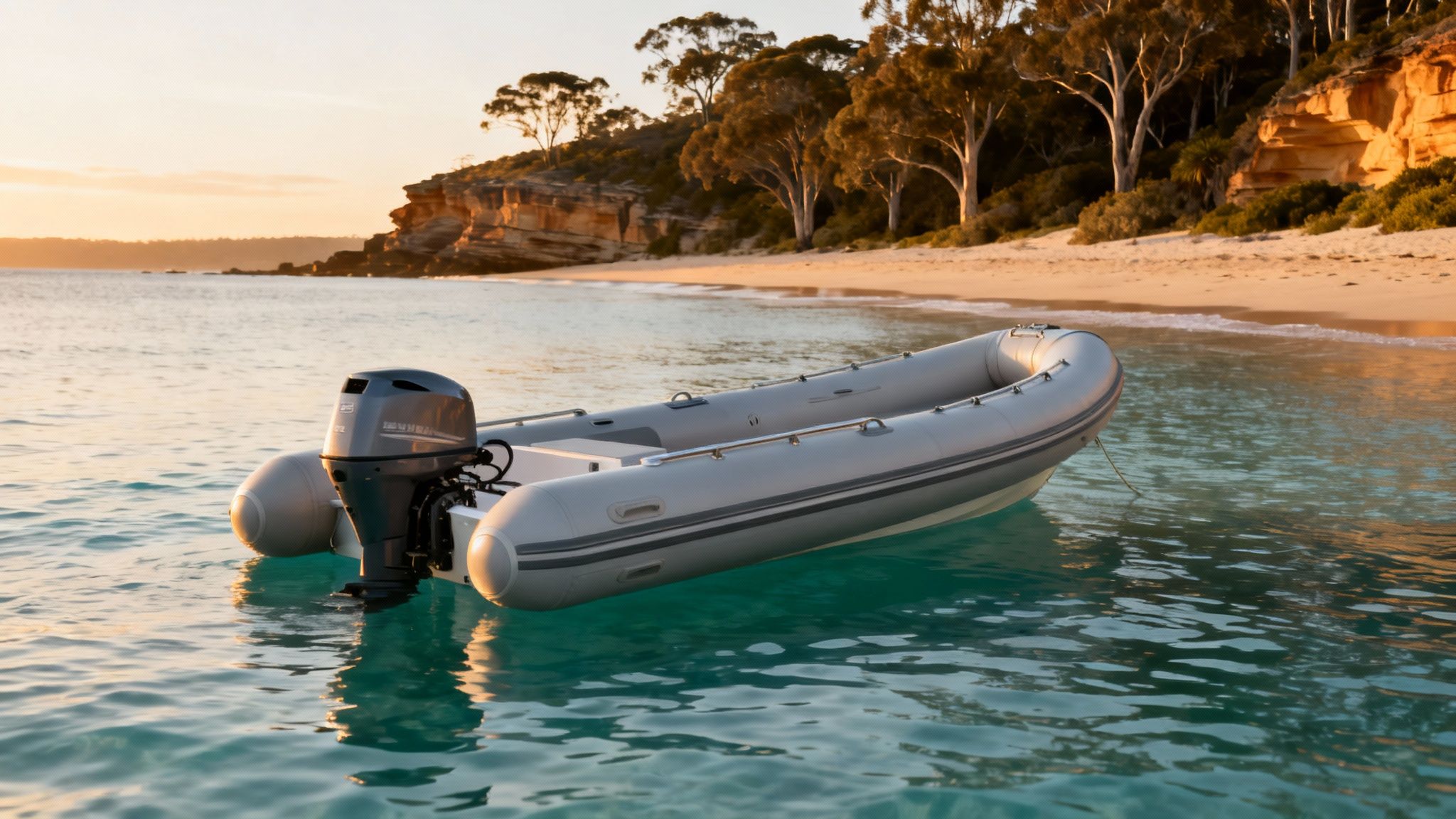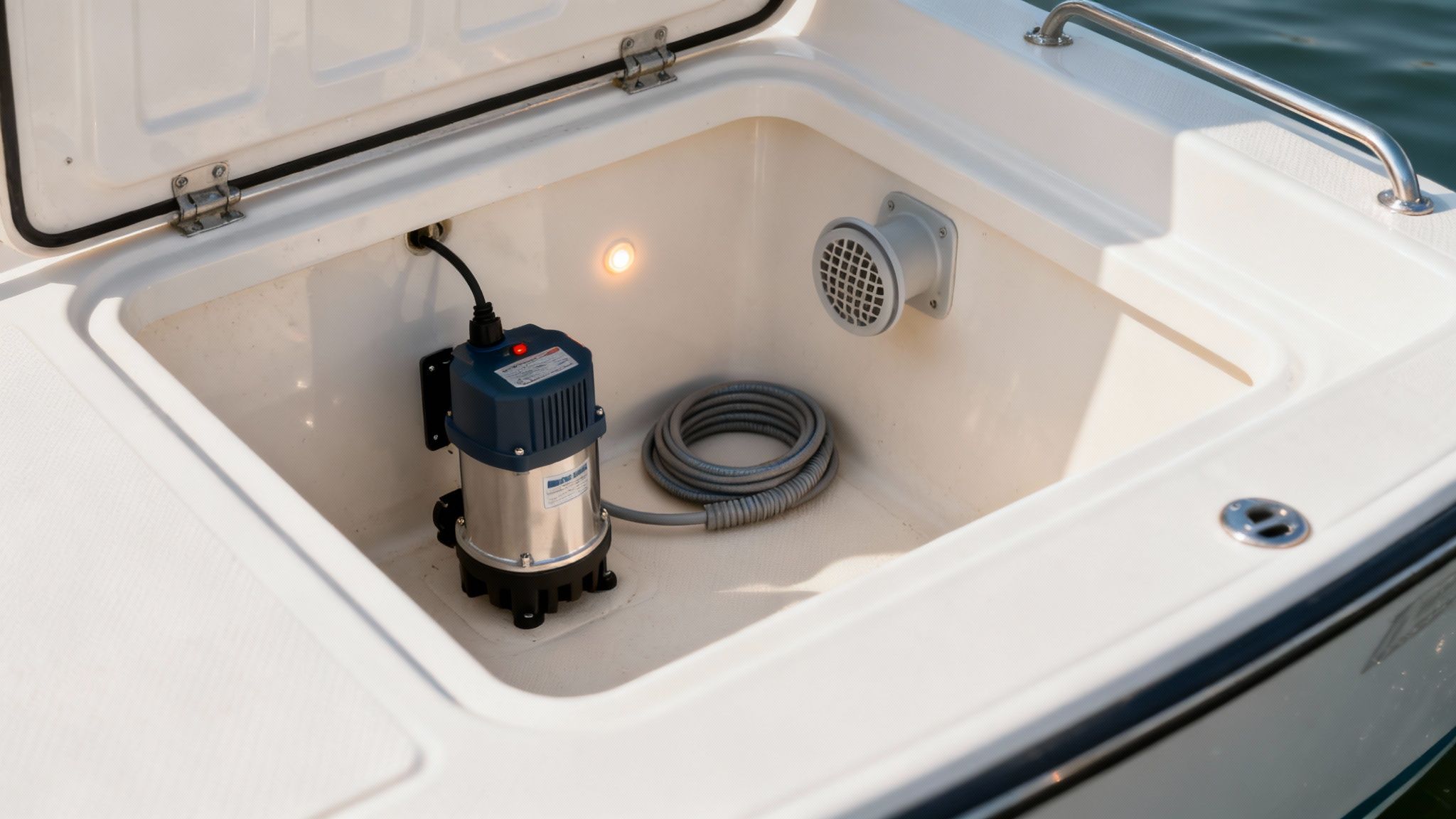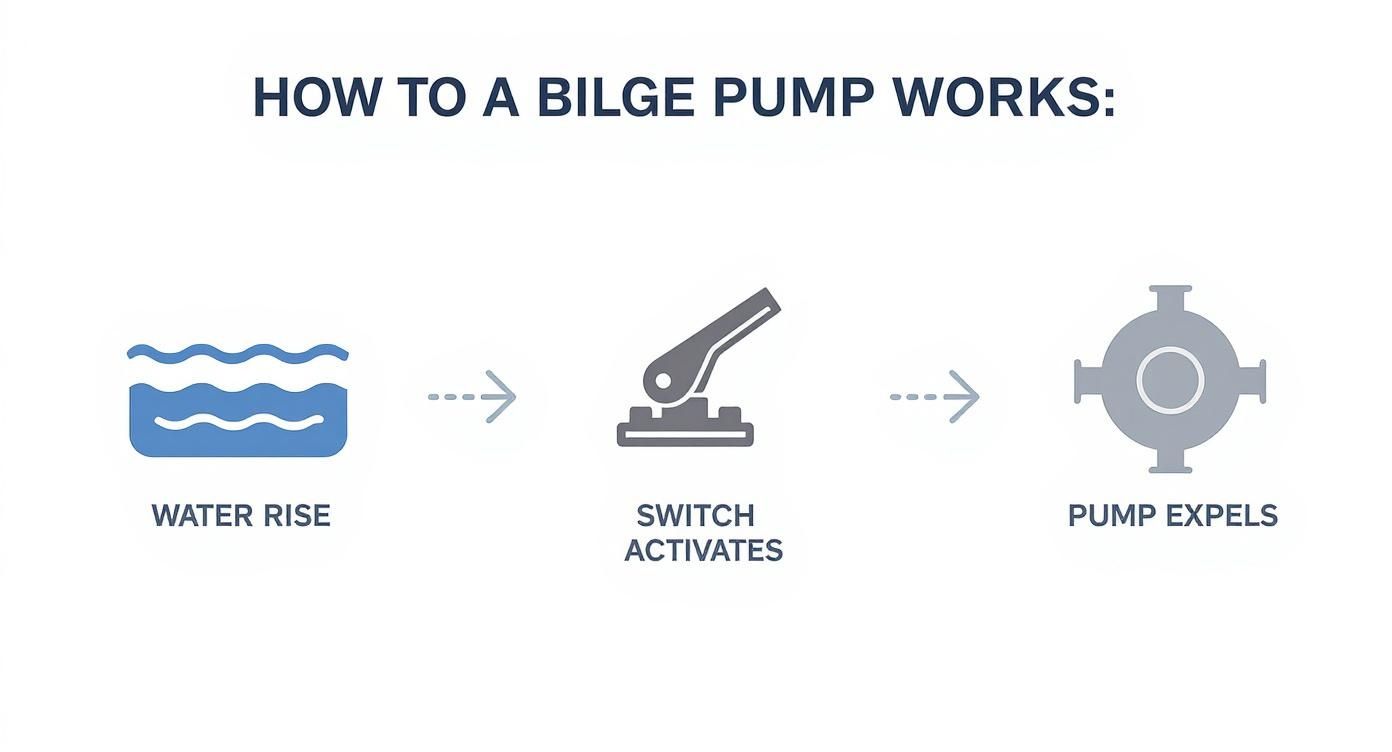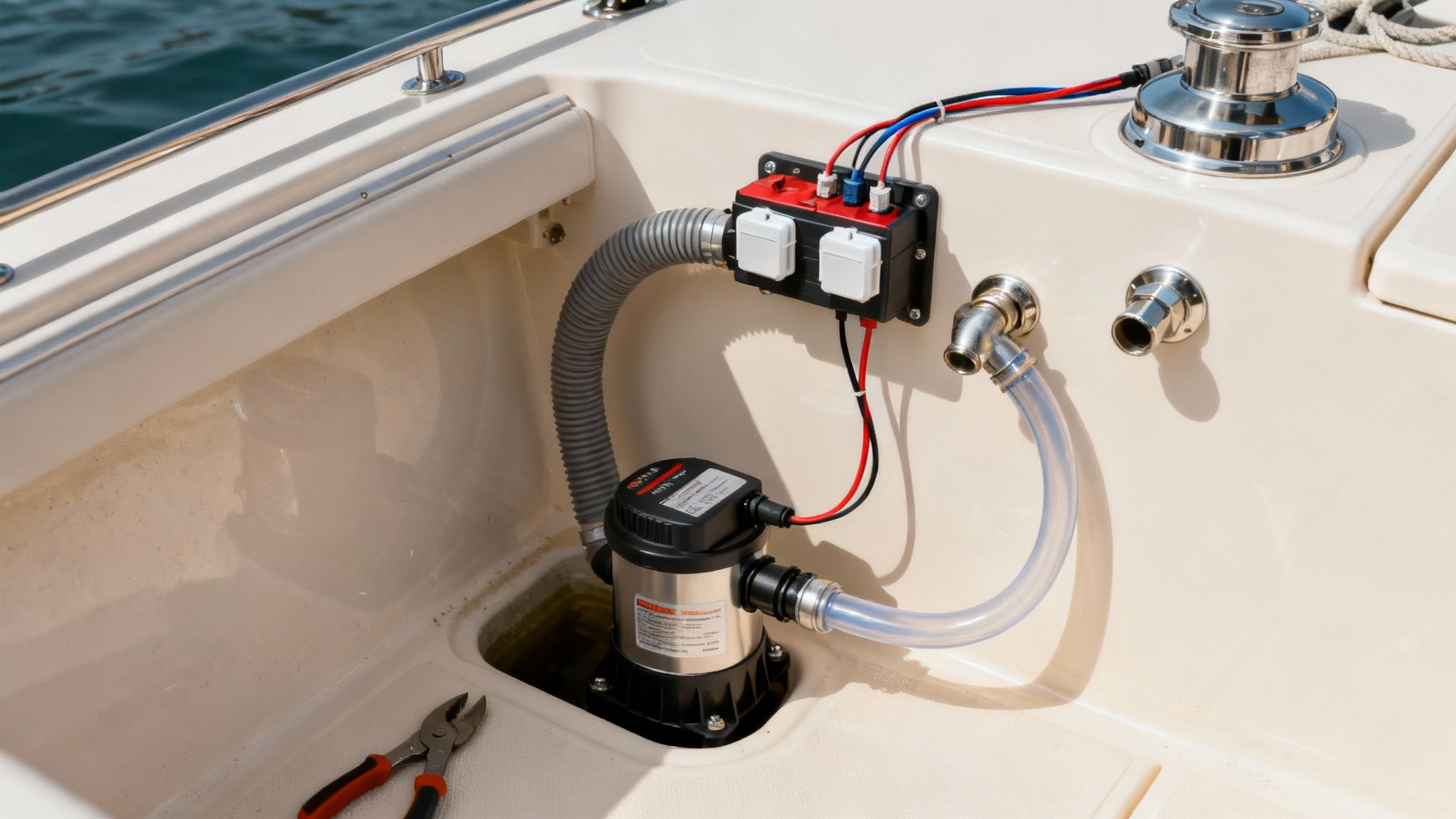
Think of an automatic bilge pump as the silent, tireless guardian of your boat. Tucked away below deck, it’s your first line of defence against sinking, working automatically to remove rainwater, small leaks, or any other unexpected water without you ever having to lift a finger. Whether you're comparing prices and features of automatic bilge pumps for a family cruiser or looking for the best options for recreational use, understanding this vital piece of equipment is key.

It’s a bit like the automated sump pump you’d find in a home’s basement. It just sits there quietly, doing its job in the background, offering constant protection whether you're on board enjoying a day out or miles away at home. For any boat owner, it's a genuine game-changer, delivering a level of security that a manual pump simply can't match, making it a critical consideration when you compare prices and features of essential boat equipment.
Moving up from a manual system is a massive step towards greater peace of mind. While it's still smart to know your way around manual bilge pumps, an automated system ensures your vessel is protected 24/7. This constant vigilance is absolutely vital, as even a tiny, unnoticed leak can spiral into a serious problem over time.
An automated pump defends against the most common ways water finds its way into a boat. Its main benefits are pretty clear:
At its heart, an automatic bilge pump provides proactive, autonomous water removal. It’s not just a convenience; it’s a fundamental safety system designed to stop a minor issue from becoming a catastrophic failure.
The demand for this essential bit of kit is huge. The global market was valued at around USD 1.2 billion in 2022, which really shows how important it is to boaters worldwide. Here in Australia, with our massive coastline and vibrant boating culture, that demand is just as strong, with new tech constantly making these pumps safer and more efficient.
Think of an automatic bilge pump as a simple, three-part system working in perfect harmony to keep your boat dry. At its heart, you have the pump motor, an activation switch or sensor, and a discharge outlet. When these three pieces work together, they create an autonomous defence against any unwanted water sloshing around in your hull.
The whole process kicks off when water—maybe from a bit of rain or a small leak—starts to pool in the bilge, which is the lowest point inside your boat. As that water level creeps up, it triggers the activation mechanism. This is the crucial moment where the system decides it's time to get to work.
The real magic of an automatic bilge pump is how it knows when to turn on. That job falls to the activation switch, which generally comes in two main flavours, each with its own pros and cons.
No matter which type you have, the switch is the command centre. To get a better handle on how a pump is controlled, our guide on the bilge pump float switch offers a deeper look into the wiring and operation.
The activation switch acts as the pump's vigilant lookout. Whether it’s a simple float or a clever electronic sensor, its one and only job is to spot rising water and send the signal to start pumping—long before it becomes a problem.
Once the switch is triggered, it sends a 12V or 24V electrical current straight to the pump's motor. This motor spins up an impeller—a small, fan-like part that rotates at high speed. As the impeller spins, it creates powerful suction that pulls water from the bilge into the pump housing.
From there, the centrifugal force from the spinning impeller shoves the water out through a discharge hose. This hose is routed up and out of the hull through a thru-hull fitting, safely spitting the water overboard. This cycle repeats itself completely automatically whenever the water level rises, keeping your boat dry and safe without you ever having to lift a finger.
Picking the right automatic bilge pump isn’t just another purchase—it’s one of the most important safety decisions you'll make for your vessel. Get it right, and you have peace of mind. Get it wrong, and you could be in serious trouble. When you compare prices and features, you're not just shopping; you're investing in your boat's safety.
The whole decision really boils down to a few key things, starting with the big one: pump capacity. This is measured in Gallons Per Hour (GPH) or Litres Per Hour (LPH).
That GPH rating tells you exactly how much water a pump can shift when everything’s perfect. The trick is matching that power to your boat’s size and the kind of water you’re in. A little tinnie for estuary fishing has completely different needs than a big cruiser heading offshore.
It’s a classic mistake: going for an undersized pump to save a few bucks. Sure, a small pump can probably handle a bit of rainwater or a slow drip from a fitting, but it will be totally swamped in a real emergency.
The aim is to have a pump that can keep up with serious water coming in, giving you precious time to sort out the problem or call for help.
Here’s a rough guide to get you started:
This infographic breaks down how an automatic bilge pump works in three simple stages.

As you can see, it’s a seamless cycle—from detecting water to pumping it overboard—that highlights just how efficient an automated system is.
While capacity gets all the attention, a few other factors are just as crucial for making sure your pump actually works when you need it most.
Choosing the right automatic bilge pump involves more than just picking the highest GPH. By comparing these key features, you can find a pump that truly fits your boat's specific needs, ensuring it's ready to perform when it matters most.
| Feature | What to Consider | Why It Matters for Your Boat |
|---|---|---|
| Physical Footprint | Measure the space in your bilge. Will the pump fit in the lowest point where water gathers? | Bilges are tight, awkward spots. A pump that doesn’t fit properly won’t be effective, as it needs to sit where water collects first. |
| Power Draw | Check your boat’s electrical system. Is it 12V (most common in Aussie recreational boats) or 24V? | A voltage mismatch can damage the pump or your boat's wiring, leading to a critical failure when you least expect it. |
| Build Materials | Look for marine-grade plastics, stainless steel components, and robust, sealed wiring. | The Aussie saltwater environment is incredibly harsh. Corrosion-resistant materials are essential for longevity and reliability. |
After weighing these options, you'll be better equipped to select a pump that not only fits your budget but also provides the dependable protection your vessel requires.
Your pump’s reliability is only as good as its weakest component. Investing in a well-built unit designed for marine conditions isn't an upgrade—it's a necessity for safe boating.
Australia’s love for recreational boating is a huge driver behind our country’s pump market, which was valued at USD 2.75 billion in 2023. Our strict maritime laws also play a part, requiring efficient bilge systems to protect our waterways from pollution. This has spurred innovation in compact, tough, corrosion-resistant automatic bilge pumps designed specifically for the saltwater conditions around our coasts. You can dive deeper into the Australian pumps market over at TechSci Research.

A correctly installed automatic bilge pump is the difference between a reliable safety net and a false sense of security. While we always recommend calling in a professional for complex jobs, knowing the fundamentals empowers you to tackle a DIY project or confidently oversee the work being done on your boat.
The whole job starts with picking the right spot. Your pump must be mounted at the lowest point of the bilge, right where water is going to collect first. A pump that’s even slightly too high can leave pools of water sloshing around in the hull, defeating its purpose entirely.
Once you've found that perfect low point, the setup involves a few critical stages. Don’t rush this part—each step is vital to ensure your pump works flawlessly when you need it most. A shortcut here could lead to a major failure down the track.
Mounting the Pump: Secure the pump base firmly to the hull using marine-grade stainless steel screws. It needs to sit flat and stable so it won’t tip over or get knocked loose by the boat's movement in rough seas.
Connecting the Hose: Attach a smooth-bore, reinforced discharge hose to the pump's outlet. Secure it with two stainless steel hose clamps, not just one. This double-clamping is cheap insurance against the hose popping off under pressure.
Routing the Discharge: Run the hose up to a thru-hull fitting that’s located well above the waterline. The path should be as short and straight as you can make it to maximise pumping efficiency and get water out fast.
Wiring is where so many DIY installations go wrong. An automatic bilge pump is your 24/7 guardian, so it needs a bulletproof power source. Getting the wiring right is non-negotiable for safety.
A crucial safety feature is the anti-siphon loop. This is simply a high arch in the discharge hose that rises above the waterline before it drops back down to the thru-hull fitting. Think of it like a one-way gate—it stops seawater from flowing back into your bilge when the boat heels over or gets hit by a big wave.
For reliable power, the pump must be wired directly to the battery through an appropriately sized fuse. This ensures it has power even when you shut off the main battery switch at the helm. It’s also essential to use heat-shrink, sealed connectors to prevent corrosion—the number one enemy of marine electrical systems. Our detailed guide offers more advice on a proper bilge pump setup.
The growth in Australia’s maritime industry highlights just how important reliable equipment is. The broader Australian hydraulic pump market was valued at USD 278.88 million in 2024 and is projected to grow significantly. This trend shows a strong investment in better pumping solutions across the board, especially in key regions like Queensland and Western Australia, where robust automatic bilge pumps are essential for vessel safety. You can dive deeper into these market trends and what they mean for marine tech in this in-depth market analysis.
Your automatic bilge pump is an out-of-sight, out-of-mind hero until the moment it fails. Regular checks are completely non-negotiable for this critical piece of safety gear, transforming it from a potential weak spot into a reliable guardian.
Think of it like checking the oil in your car; you don't wait for the engine to seize before you look at the dipstick. The same logic applies here. A few minutes spent on a simple checklist can be the difference between a minor inconvenience and a genuine disaster on the water.
Keeping your pump in top condition doesn't require a full toolkit or hours of your time. By folding these quick tasks into your regular boating routine, you'll massively extend its lifespan and boost its reliability. It's a core part of responsible boat ownership, much like the checks we cover in our guide to inflatable boat maintenance made simple.
Even with perfect maintenance, things can still go wrong. Knowing how to quickly diagnose common problems with your automatic bilge pump will give you the confidence to sort them out on the spot.
Don't panic when your pump plays up. Most issues have simple causes and straightforward fixes. Running through a quick diagnostic check will often pinpoint the problem in minutes, stopping a small issue from becoming a big one.
Use this simple table to identify what's going on and how to fix it.
| Problem | Likely Cause(s) | Solution(s) |
|---|---|---|
| Pump won't turn on | A blown fuse, corroded wiring, or a dead battery. | Check and replace the fuse. Clean the wire terminals and make sure every connection is tight. |
| Pump runs but moves no water | A clogged intake strainer or a kinked discharge hose. | Clear any debris from the strainer. Straighten the hose to ensure water has a clear path out. |
| Pump runs continuously | A stuck or faulty float switch, or a major leak. | Check the float switch for any debris jamming it in the 'on' position and give it a good clean. |
Getting your head around marine safety gear can feel like a chore, but when it comes to something as vital as an automatic bilge pump, having clear answers is non-negotiable. It’s what keeps your boat afloat and gives you peace of mind. Let’s tackle some of the most common questions we hear from boat owners.
First things first: every boat is different. A one-size-fits-all approach to bilge pumps just doesn't work. What’s perfect for a small inflatable tender won't cut it for a larger family cruiser, so you need to think about your boat's specific layout and how you use it. For instance, if you're looking for the best inflatable boats for recreational use in your area, the bilge pump requirements will be different from those for a large offshore vessel.
This really comes down to your boat’s size and how it’s built. A good rule of thumb is that every separate, watertight compartment needs its own pump. Think about it—if water floods one sealed area, a pump in another compartment is completely useless.
For most boats over 6 metres (around 20 feet), you absolutely need at least two pumps. It’s a critical safety redundancy. Here's how to set it up:
Yes, it absolutely can, and it's a risk every boat owner needs to take seriously. If a faulty float switch gets jammed in the 'on' position, or you have a persistent leak that keeps the pump cycling, it will eventually run your battery flat.
That could leave you stranded without power for your engine, navigation lights, or radio. To stop this from happening, get into the habit of regularly checking your float switch and fixing any leaks as soon as you find them. Many boaters wire their bilge pump to a separate house battery or install a smart battery management system to make sure the engine's starting battery is always protected.
The main difference is how they detect water.
A float switch is a simple mechanical device. It’s basically a buoyant float on a lever. As the water level rises, the float lifts, flipping a switch that completes the circuit and turns the pump on. They're cheap and cheerful, but they can sometimes get stuck or jammed by debris sloshing around in the bilge.
An electronic sensor, on the other hand, has no moving parts to fail. It uses two small electrical probes to sense water.
When the water level gets high enough to touch both probes, it completes the electrical circuit and triggers the pump. These sensors are far more reliable in rough seas and less likely to get clogged, making them a popular upgrade for boaters who want that extra layer of confidence.
Yes, it is strictly illegal. You cannot discharge any water containing oil, fuel, or other pollutants into Australian waters. Pumping oily bilge water overboard isn't just bad for the environment; it comes with hefty fines for boat owners who get caught.
You have a legal responsibility to keep your bilge clean. The best way to do this is by using oil-absorbent pads to soak up any accidental spills from the engine. Once those pads are saturated, you must dispose of them properly on shore—never throw them overboard. For larger vessels, regulations often require an oil-water separator to be installed to ensure you’re complying with Australian maritime law.
At Easy Inflatables, we believe that safety and confidence on the water start with the right gear. Whether you're looking for a durable inflatable boat for family adventures or need expert advice on essential accessories, we have you covered. Explore our range of high-quality boats and equipment designed for Australian conditions. For those wondering where to hire inflatable boats for a family outing in Australia, start by ensuring your chosen vessel has the best safety equipment.
Discover the perfect inflatable boat for your needs at Easy Inflatables
Experience the ultimate freedom on the water with our top-quality inflatable boats and accessories. Easy Inflatables is your trusted partner, providing everything you need for a safe and unforgettable adventure.
At Easy Inflatables, we believe in empowering adventurers with high-quality inflatable solutions. Our commitment to durability and performance ensures that every product enhances your outdoor experiences.